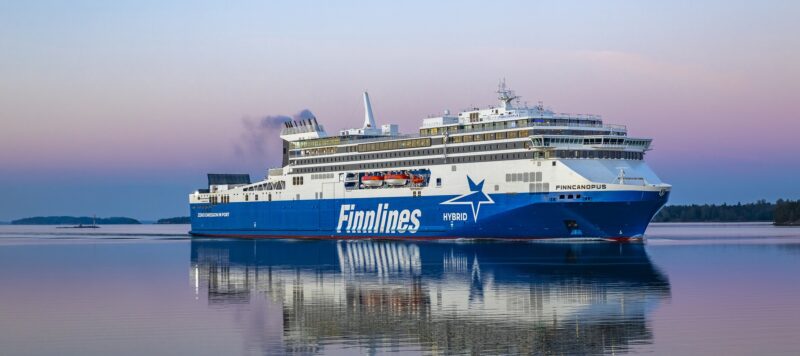Finnlines’ Finncanopus has been operating for a year on the route between Finland and Sweden – passenger figures have doubled
Finnlines’ Superstar-class vessel Finncanopus celebrates its first anniversary on 16 February 2025. The two Superstar vessels have significantly reduced the carbon footprint of the route.

Photo: Janne-Petteri Kumpulainen / Finnlines Plc.
Finnlines’ second Superstar-class hybrid freight-passenger vessel, Finncanopus, joined the sister vessel Finnsirius on the route between mainland Finland, Åland and Sweden on 16 February 2024. The two new vessels are an important part of the strategy to provide upgraded services. They have been specifically designed for the unique archipelago route and have a capacity of 5,200 lane metres for freight and may carry up to 1,100 passengers. The number of passengers on the Naantali-Långnäs-Kapellskär route more than doubled during the past year.
Finnlines calls Åland four times a day, with two departures to Sweden and two to mainland Finland. The route stands as the fastest sea connection between southern Finland and Sweden.
“We are delighted by the warm welcome that Finnsirius and Finncanopus have received from both private travellers and professional drivers. The Superstar vessels are specifically designed for the fast-paced Finland-Sweden traffic. Loading and unloading operations are efficient, which helps minimise the turnaround times. With our new ships, we have entered the hybrid era, offering our customers more efficient and sustainable sea transport services,” says Antonio Raimo, Line Manager at Finnlines.
”Finnsirius and Finncanopus represent a new generation of vessels in the Finnlines fleet. Onboard services have become more diverse with a variety of restaurants, a stylish spa, yoga studio, and a tax-free shop. Furthermore, we can offer day trips, also known as picnic cruises, which enable a refreshing escape form everyday life, surrounded by stunning archipelago views,” says Marco Palmu, Head of Finnlines Passenger Services.
”The Superstar ships provide modern facilities for an efficient team meeting, a kick-off or management meeting. A meeting at sea is a perfect alternative to a meeting ashore,” says Marco Palmu.
Sustainable travel
Efficient transport of goods enables sustainable passenger travel as the carbon footprint per passenger remains low when carriage of freight and passengers is combined. Finnlines’ ro-pax concept ensures a high utilisation rate even during seasonal ups and downs.
The Superstar-class Finncanopus and Finnsirius are equipped with many energy-saving technologies. Thanks to high-powered battery units, the use of main engines can be reduced. The air lubrication under the keel reduces resistance and saves fuel. Onshore power connection enables zero emissions at berth. An automatic ship mooring system speeds up the mooring and unmooring of vessels and reduces emissions in port. Even though the vessel capacity has significantly increased, the absolute CO2 emissions per nautical mile between Finland and Sweden is 22 per cent lower compared with the previous vessels on the route.
The entry of the two Superstars marked the completion of Finnlines’ EUR 500-million Green Investment Programme, which also consisted of three freight vessels, all of which entered Finnlines services in 2022.
More information
Antonio Raimo, Line Manager, Finnlines Plc
[email protected], +46 70 725 0380
Marco Palmu, Head of Passenger Services, Finnlines Plc
[email protected], +358 40 773 4894
Photo requests and other inquiries
[email protected]
Finnlines Plc
Finnlines is a leading shipping operator of freight and passenger services in the Baltic Sea, the North Sea and the Bay of Biscay. The company is a part of the Grimaldi Group, one of the world’s largest operators of ro-ro vessels and the largest operator of the Motorways of the Sea in Europe for both passengers and freight. This affiliation enables Finnlines to offer liner services to and from any destination in the Mediterranean, West Africa, North and South America as well as Asia and Australia.